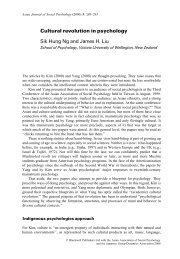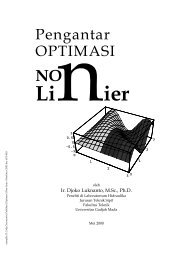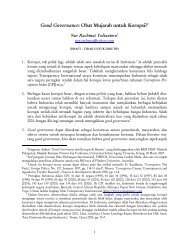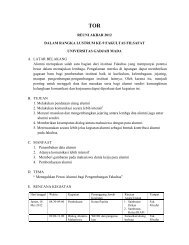Estimating the Codifference Function of Linear Time Series Models ...
Estimating the Codifference Function of Linear Time Series Models ...
Estimating the Codifference Function of Linear Time Series Models ...
You also want an ePaper? Increase the reach of your titles
YUMPU automatically turns print PDFs into web optimized ePapers that Google loves.
definition <strong>of</strong> <strong>the</strong> codifference function (for θ 1 , θ 2 ∈ R)<br />
τ G (θ 1 , θ 2 ; k) = − lnE exp(i(θ 1 X t+k + θ 2 X t )) + ln E exp(iθ 1 X t+k ) + ln E exp(iθ 2 X t ) (18)<br />
but contain (4) as <strong>the</strong> special case (θ 1 = s, θ 2 = −s).<br />
Theorem A.1 (Kokoszka and Taqqu (1994), Theorem 2.1.) If <strong>the</strong> coefficients c j ’s <strong>of</strong> <strong>the</strong><br />
linear process (1), satisfying conditions C1 and {ǫ t } satisfying C2 <strong>the</strong>n (θ 1 , θ 2 ∈ R)<br />
and<br />
lim sup<br />
k→∞<br />
limsup<br />
k→∞<br />
⎛<br />
∞∑<br />
Q k |τ G (k)| ≤ α ⎝<br />
Q αk |τ G (k)| ≤ 2(1 − Q α ) −1/α |θ 1 | α for 0 < α ≤ 1 (19)<br />
j=0<br />
⎞ α−1<br />
α<br />
|c j | α ⎠ (1 − Q α ) −1/α |θ 1 | |θ 2 | α−1 for 1 < α ≤ 2 (20)<br />
To show consistency <strong>of</strong> <strong>the</strong> codifference estimator, <strong>the</strong> following two lemmas are necessary.<br />
Lemma A.2 Let X t , t ∈ Z be <strong>the</strong> stationary linear process (1), satisfying conditions C1 and C2,<br />
and let Φ(s) = E exp(isX t ) denote its first order characteristic function. For k ∈ {0, 1, 2 . . .} and<br />
s ∈ R, s ≠ 0<br />
(<br />
)<br />
N−k<br />
∑<br />
lnφ(s, k) = ln (N − k) −1 exp(isX t )<br />
is a consistent estimator <strong>of</strong> ln Φ(s).<br />
Pro<strong>of</strong>.Let y t = exp(isX t ). Apparently, <strong>the</strong> magnitude <strong>of</strong> y t is equal to one, and <strong>the</strong>refore it is a<br />
second order stationary process. For <strong>the</strong> notation simplicity, instead <strong>of</strong> working with φ(s, k), we<br />
first show consistency <strong>of</strong> φ ∗ (s, k) = N −1 ∑ N<br />
t=1 exp(isX t). Here, φ ∗ (s, k) is an unbiased estimator<br />
for Φ(s) = E(y t ). To show <strong>the</strong> weak consistency <strong>of</strong> this estimator, we show that y t is a mean<br />
ergodic process. A sufficient condition for y t to be mean ergodic, i.e., φ ∗ (s, k) → E(y t ) in <strong>the</strong> mean<br />
square sense, is that its covariance function tends to zero as time lags tends to ∞ (e.g., Theorem<br />
7.1.1. in Brockwell and Davis, 1987). The covariance function <strong>of</strong> y t at lag k can be expressed as<br />
(<br />
)<br />
c(k) = |Φ(s)| 2 E(exp(is(X t+k − X t )))<br />
E(exp(isX t+k ))E(exp(−isX t )) − 1 = |Φ(s)| 2 (exp(−τ(k)) − 1) (21)<br />
From Theorem A.1, we see that c(k) → 0 when k → ∞ exponentially fast. As mean square<br />
convergence entails convergence in probability, φ ∗ (s, k) −→ p Φ(s). Moreover, under assumptions C1<br />
and C2, we have Φ(s) = exp(− ∑ ∞<br />
j=0 σα |sc j | α ), a real-valued function. Therefore we can conclude<br />
Re φ ∗ (s, k) −→ p Re Φ(s) = Φ(s) and Imφ ∗ (s, k) −→ p ImΦ(s) = 0.<br />
By taking <strong>the</strong> principal value <strong>of</strong> ln(·) function in <strong>the</strong> complex domain, we can see that ln(·)<br />
is a continuous and well-defined function on C minus <strong>the</strong> negative real line. Because |c j | < cQ −j<br />
for some c > 0, Q > 1, we conclude Re Φ(s) always strictly greater than 0, which implies with<br />
<strong>the</strong> probability converging to 0, Re φ ∗ (s, k) will be less than or equal to 0. Therefore, without<br />
loss <strong>of</strong> generality, we can restrict <strong>the</strong> definition <strong>of</strong> <strong>the</strong> real and imaginary parts <strong>of</strong> lnφ ∗ (s, k)<br />
only on <strong>the</strong> right half plane where Reφ ∗ (s, k) > 0, and equal to 0 on <strong>the</strong> o<strong>the</strong>r case. From this<br />
consideration, we obtain Re lnφ ∗ (s, k) = 1 2 ln((Re φ∗ (s, k)) 2 + (Im φ ∗ (s, k)) 2 ) and Imlnφ ∗ (s, k) =<br />
arctan( Im φ∗ Re φ ∗ (s,k)). From <strong>the</strong> continuity <strong>of</strong> <strong>the</strong> logarithm function in <strong>the</strong> considered domain, we<br />
can deduce that Re lnφ ∗ p<br />
(s, k) −→ Re ln Φ(s) = ln Φ(s) and Imlnφ ∗ (s, k) = argφ ∗ (s, k) −→ p 0,<br />
when N → ∞. In o<strong>the</strong>r words, we obtain lnφ ∗ (s, k) −→ p ln Φ(s). To complete our pro<strong>of</strong>, it<br />
is sufficient to show φ ∗ (s, k) − φ(s, k) −→ p 0. By assumption <strong>of</strong> <strong>the</strong> model, Re Φ(s) > 0, thus<br />
E |Re φ ∗ (s, k) − Re φ(s, k)| < 2 k<br />
N−k and E |Im φ∗ (s, k) − Im φ(s, k)| < 2 k<br />
N−k<br />
, and <strong>the</strong>refore we<br />
can conclude φ ∗ (s, k) − φ(s, k) = o p (1).<br />
t=1<br />
9












